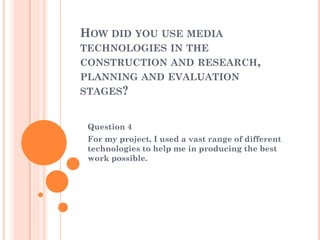How did you use media technologies in the construction and research, planning and evaluation stages?
- 1. HOW DID YOU USE MEDIA TECHNOLOGIES IN THE CONSTRUCTION AND RESEARCH, PLANNING AND EVALUATION STAGES? Question 4 For my project, I used a vast range of different technologies to help me in producing the best work possible.
- 2. TIMETOAST At the beginning, I used timetoast to create my production schedule to help me plan my project and allow time for contingencies. I found timetoast useful as I could clearly see what I would be doing each week and when I needed to complete certain tasks by.
- 3. SPIDERSCRIBE When planning ideas for our short film, I used spiderscribe. I don’t usually like mind maps but because spiderscribe is online, it is easy to create and change and very clear to understand.
- 4. PREZI Prezi was used to create pitches to show the class. I like Prezi as it is a creative way to present ideas to the class. I especially like the different templates available and being able to choose templates fit for purpose.
- 5. YOUTUBE We used YouTube to upload videos which we could them embed onto our blogs so you could watch our pitch, audience feedback and final film videos. I think YouTube is a fast and effective way to upload videos as it is then available to a global audience and this would be useful if we wanted to reach out to an international market.
- 6. DSLR We used the Canon DSLR camera to film our video. This camera was very high quality and the focus lens were useful as we were able to get the clearest/best shots possible. We could also change the settings (to night mode) when we were filming in the dark so our shots still looked clear.
- 7. FINAL CUT PRO To edit our film, I used final cut pro. This programme was very easy to understand and use as a lot of the changes could be done using shortcut keys which made it a fairly quick process. I could also add music to the scenes as well as transitions to make each shot fit together well.
- 8. VINE While we were editing, we uploaded vines of our work onto our blogs. This was done in order to show progress. We chose to upload vines as they were more interactive than just doing blog posts to say what we had done.
- 9. PHOTOSHOP We used photoshop to create the poster of the film. Photoshop has some really useful tools like the spot remover tool and the various colour correction tools (brightness, contrast etc) we used these and other tools to make our picture and poster of the best quality possible. We were also able to add text onto our image as well as banners to make it look Professional, real and eye catching.
- 10. IN DESIGN We used in design to create our magazine review. In design was useful as it has margins which enable us to create and align columns. At first, it was a bit tricky getting used to the software but after a while it made more sense and we were able to add titles, images and the star rating as well.
- 11. BLOGGER Throughout this project, I used blogger to update my progress and write down ideas that my group and I had so I could go back and look at them later. I also used this blog to reflect on my performance and what I thought of my work. I think blogger has been the most useful technology in this project as it allowed me to stay up to date with the work my peers were doing and blogging after lessons made it easy for me to see what work had been completed and what still needed to be done.











